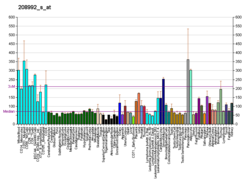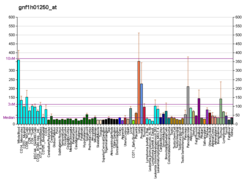STAT3
| STAT3 | |||||||||||||||||||||||||||||||||||||||||||||||||||
|---|---|---|---|---|---|---|---|---|---|---|---|---|---|---|---|---|---|---|---|---|---|---|---|---|---|---|---|---|---|---|---|---|---|---|---|---|---|---|---|---|---|---|---|---|---|---|---|---|---|---|---|
 | |||||||||||||||||||||||||||||||||||||||||||||||||||
| |||||||||||||||||||||||||||||||||||||||||||||||||||
| Identifiants | |||||||||||||||||||||||||||||||||||||||||||||||||||
| Aliases | STAT3 | ||||||||||||||||||||||||||||||||||||||||||||||||||
| IDs externes | OMIM: 102582 MGI: 103038 HomoloGene: 7960 GeneCards: STAT3 | ||||||||||||||||||||||||||||||||||||||||||||||||||
| |||||||||||||||||||||||||||||||||||||||||||||||||||
| |||||||||||||||||||||||||||||||||||||||||||||||||||
| |||||||||||||||||||||||||||||||||||||||||||||||||||
| |||||||||||||||||||||||||||||||||||||||||||||||||||
| |||||||||||||||||||||||||||||||||||||||||||||||||||
| Wikidata | |||||||||||||||||||||||||||||||||||||||||||||||||||
| |||||||||||||||||||||||||||||||||||||||||||||||||||
Le STAT3 (pour « Signal transducer and activator of transcription 3 ») est un facteur de transcription appartenant à la STAT. Son gène est le STAT3 situé sur le chromosome 17 humain.
Rôles
Il régule la synthèse de plusieurs microARNs[5] et intervient dans l'inflammation, l'apoptose et l'immunité. Il favorise l'angiogenèse par la prolifération des cellules musculaires lisses vasculaires et de l'intima[6], notamment par l'activation du facteur de croissance de l’endothélium vasculaire[7] par le biais de l'interleukine 6[8].
Membre de la famille des protéines STAT, ce facteur de transcription est activé en réponse à une stimulation par des cytokines (comme l'IL-6, notamment) ou des facteurs de croissance. La fixation de protéines membres de la famille des IL-6 (IL-6, LIF, CNTF, etc.) induit une activation de Src, puis de JAK2 qui phosphoryle STAT3. En réponse à ces signaux (cytokines et facteurs de croissance), les membres de la famille STAT sont phosphorylés par des kinases présentes sur le domaine intracytosolique du récepteur membranaire au signal. La phosphorylation précède l'homodimérisation ou l'hétérodimérisation des facteurs STAT qui subissent alors une translocation nucléaire leur permettant d'agir ainsi (avec une plus forte affinité sous forme de dimère) avec un promoteur d'un gène afin de promouvoir la transcription de certains gènes en réponse au signal de base.
STAT3 est activée grâce (notamment) à une phosphorylation sur son résidu Tyrosine 705 (par exemple, par les Janus kinases) et éventuellement en Sérine 727 également. Ces phosphorylations peuvent se faire en réponse à une stimulation par des interférons, de l'EGF, des interleukines (IL-5, IL-6, etc.), des hormones comme la leptine, etc. STAT3 permet l'expression et la stimulation de la transcription de nombreux gènes en réponses à des stimuli. Il semblerait que STAT3 ait des rôles dans la différenciation, l'apoptose mais aussi la mitose et la croissance cellulaire.
STAT3 voit son activité régulée par une GTPase, Rac1, se fixant au facteur de transcription STAT3. La protéine PIAS3, elle, est connue pour être un inhibiteur spécifique de STAT3.
STAT3 expression can be regulated by notch signalling[9].
Cible thérapeutique
L'inhibition du STAT3 semble prometteur dans de nombreuses maladies, dont le psoriasis[10] ou certains cancers (par inhibition de l'angiogenèse[11]). Elle constitue une piste pour le traitement de l'athérome et de l'hypertension artérielle pulmonaire[12].
Cette action est menée par l'administration d'oligonucléotides inhibant l'expression du gène de la protéine[13].
Notes et références
- ↑ a b et c GRCh38: Ensembl release 89: ENSG00000168610 - Ensembl, May 2017
- ↑ a b et c GRCm38: Ensembl release 89: ENSMUSG00000004040 - Ensembl, May 2017
- ↑ « Publications PubMed pour l'Homme », sur National Center for Biotechnology Information, U.S. National Library of Medicine
- ↑ « Publications PubMed pour la Souris », sur National Center for Biotechnology Information, U.S. National Library of Medicine
- ↑ Haghikia A, Hoch M, Stapel B, Hilfiker-Kleiner D, STAT3 regulation of and by micrornas in development and disease, Jak-Stat, 2012;1:143–150
- ↑ Daniel JM, Dutzmann J, Bielenberg W et al. Inhibition of STAT3 signaling prevents vascular smooth muscle cell proliferation and neointima formation, Basic Res Cardiol, 2012;107:261
- ↑ Niu G, Wright KL, Huang M et al. Constitutive STAT3 activity up-regulates VEGF expression and tumor angiogenesis, Oncogene, 2002;21:2000–2008
- ↑ Loeffler S, Fayard B, Weis J, Weissenberger J, Interleukin-6 induces transcriptional activation of vascular endothelial growth factor (VEGF) in astrocytes in vivo and regulates VEGF promoter activity in glioblastoma cells via direct interaction between STAT3 and SP1, Int J Cancer, 2005;115:202–213
- ↑ (en) Sachiko Kamakura, Koji Oishi, Takeshi Yoshimatsu et Masato Nakafuku, « Hes binding to STAT3 mediates crosstalk between Notch and JAK–STAT signalling », Nature Cell Biology, vol. 6, no 6, , p. 547–554 (ISSN 1465-7392 et 1476-4679, DOI 10.1038/ncb1138, lire en ligne, consulté le )
- ↑ Miyoshi K, Takaishi M, Nakajima K et al. STAT3 as a therapeutic target for the treatment of psoriasis: a clinical feasibility study with STA-21, a STAT3 inhibitor, J Invest Dermatol, 2011;131:108–117
- ↑ Klein JD, Sano D, Sen M, Myers JN, Grandis JR, Kim S, Stat3 oligonucleotide inhibits tumor angiogenesis in preclinical models of squamous cell carcinoma, PLoS One, 2014;9:e81819
- ↑ Dutzmann J, Daniel JM, Bauersachs J, Hilfiker-Kleiner D, Sedding DG, Emerging translational approaches to target STAT3 signalling and its impact on vascular disease, Cardiovasc Res, 2015;106:365-374
- ↑ Sen M, Thomas SM, Kim S et al. First-in-human trial of a STAT3 decoy oligonucleotide in head and neck tumors: implications for cancer therapy, Cancer Discov, 2012;2:694–705
v · m | |||||||||
|---|---|---|---|---|---|---|---|---|---|
| Ligand | |||||||||
| Récepteurs aux cytokines (en) |
| ||||||||
| Janus kinase | |||||||||
| Protéines adaptatrices |
| ||||||||
 Portail de la médecine
Portail de la médecine  Portail de la biologie cellulaire et moléculaire
Portail de la biologie cellulaire et moléculaire


















